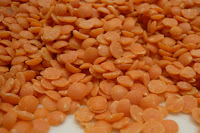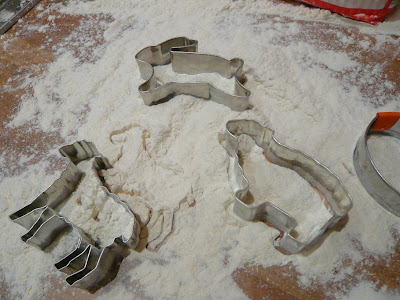
Eggplant or aubergine, brinjal or
baingan? Never mind what it's called, lots of men I know don’t seem to like this purple fruit very much. (Growing up, we ate moussaka and other eggplant favorites only on the nights that my Dad was out playing bridge.) Only Indian men seem to truly relish the eggplant. As the fruit is native to India, perhaps we had best look to that country for a tempting
baingan recipe.
This evening, we made
Baingan Bharta (Eggplant Mash), only we didn't just make one dish. We made the same dish twice, using exactly the same ingredients, but altering one cooking
technique.
The first step of every
baigan bharta recipe is to cook the eggplant whole. This is done either by roasting the eggplant on a rack in a moderate oven or by sitting the eggplant directly on top of a gas burner. We’ve tried both in the past. Generally, P and I think that the cook top method is best. However, we decided to stage an objective test, so P invited Aashvin to dinner to be our blind judge. Aashvin sat in the lounge and watched
The Apprentice while we cooked the following recipe in double quantities with each eggplant.
Ingredients:
1 egg plant
1 large onion – chopped
2 small tomatoes - chopped
2 green chillies – thinly sliced
1 tablespoon ginger - finely cut
1/4 tsp red chilli powder
1/2 tsp haldi/turmeric powder
1 tsp dhania/coriander powder
a handful of green peas (frozen is fine)
salt to taste
vegetable oil & ghee
fresh green coriander to garnishStage One
Eggplant 1
Place the whole eggplant on the centre tray of a moderate oven for 40-45 minutes. (You might want to stick a fork in a few times first, to avoid an aubergine explosion!)
 Eggplant 2
Eggplant 2
Place the whole eggplant directly onto the wire, above a middle-sized gas burner on moderate flame (see left). Rotate frequently, until the skin is black and flaky and the whole fruit is soft and mushy. Stage TwoLet the eggplants cool slightly and then peel of the skin and roughly mash the flesh.
Stage ThreeSaute the onion and the green chilies until soft. Add the dried turmeric, coriander and chili-powder and fry for another 2-3 minutes. Stir in the tomatoes and cook on a medium flame for 7-10 minutes. Stir in the brinjal. Stir in the peas. Garnish with fresh coriander. 
Aashvin was immediately able to pick the stove top brinjal (left). Indeed, it was vastly different to the oven-roasted dish (below). Not only did the stove version have a distinctive smoky taste, it was much sweeter than the other dish. (The oven-baked eggplant had a slightly bitter tang.) Surprisingly, the colour of the dishes was also quite different. While the oven-baked aubergine produced a greyish brown mash, the gas-cooked aubergine resulted in a golden coloured
bharta. (How's the Hindi coming?)
Today, not only have I discovered a hithertoo unidentified link between lexemes and flavour, but I have come to one other conclusion:

Poor, poor people who only have electric cooktops.
If you’re in Edinburgh and looking for the ingredients used in the Baingan Bharta, I can recommend
Super Asian Foods (formerly PolyPack)
27 Jocks Lodge, Edinburgh, EH8 7AA
ph. 0131 661 4966for ghee and all the necessary herbs and spices.

















 (The first
(The first 






















